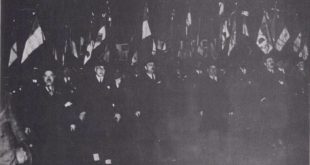AS THE 1930’s drew to a close, only eight countries in Europe, besides Great Britain and France, were still democracies. They were Belgium, Holland, Switzerland, Czechoslovakia, Norway, Sweden, Denmark and Finland. Three of Europe’s most important nations were dictatorships. The Soviet Union was communist; Germany and Italy were fascist. There had been dictatorships before, but these went further; they were totalitarian. The word “totalitarian” comes from the word “total,” and total control is what these dictatorships were after — total control of their people, total control of their actions and thought. There were differences between the totalitarian countries. While Stalin exterminated his opponents as ruthlessly as the fascists, he sought to spread his power less by war than by internal revolt. Nor did the Soviets openly preach racial war and genocide. In Germany, however, the Nazis loudly boasted that the Germans were the master race, destined to conquer all other, inferior, peoples. “Today Germany,” they said, “tomorrow the world.” Furthermore, the fascists claimed to be the only ones who could stop Communism and the communists considered the fascists their worst enemies. As a result, the communists in some countries found themselves lined up with the defenders of democracy against fascism. In France they were part of the Popular Front. In the United States they supported Roosevelt and the New Deal. In Spain they fought against Franco side by side with men who believed in democracy, although the communists later betrayed the Spanish democrats. Three ideologies competed for control of the world and as events turned out, one totalitarian nation — the Soviet Union — would finally be forced to stand with the democracies against the totalitarians of Germany, Italy and Japan in the most terrible war in the history of the world.
Read More »Democratic but Divided 1926-1939
UNLIKE Britain, France was not a highly industrialized country; its economy was fairly evenly divided between industry and farming. For this reason, the depression came to France later than it did to any of the democracies and its effect was less severe, but in no other democracy did communists and fascists play so large a part. For a time there was real danger that the French republic would be overthrown by the fascists and there were riots in the streets. One reason the fascists were so dangerous was that the French people were sharply divided in their political opinions. There were many parties of many political shades. The largest and most important was the Radical Socialist party, which was neither radical nor socialist. The name was something that had been left over from the past. It was a middle-of-the-road party, supported by the middle class and the farmers. To the left of the Radical Socialists were the Socialists, who had considerable strength and the Communists. On the extreme right were the anti-republic parties and the fascists. The most powerful of these was the Croix de Feu, the Cross of Fire. Made up mainly of war veterans, it was led by Colonel Francois de la Rocque and it won the support of a number of industrialists and financiers. Less strong, though still troublesome, were Action Francaise, Camelots du Roi, Solidarité Francaise‚ Jeunesse Patriote and the Cagoulards. Because of the number of parties, it was almost impossible for any one party to win a majority and control the government. France was governed by coalitions, or combinations, of two or more parties, which supported the premier, the head of the government. But disagreements often arose, and the parties were quick to withdraw their support of the premier. Whenever that happened, a new coalition …
Read More »

